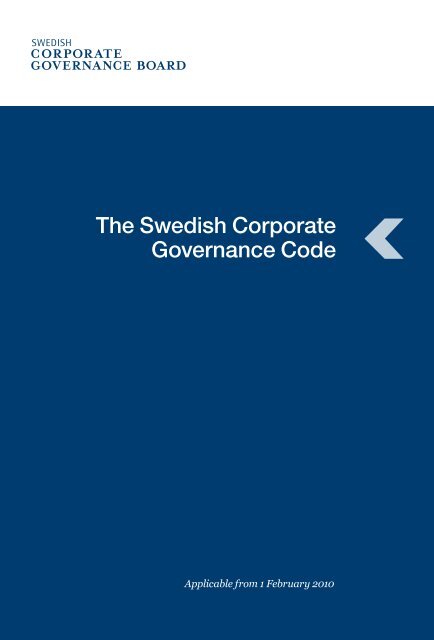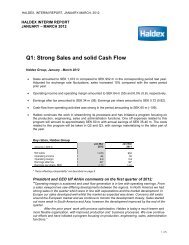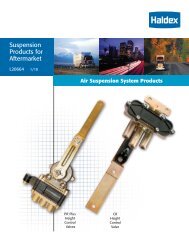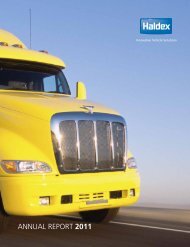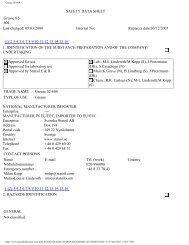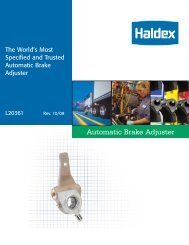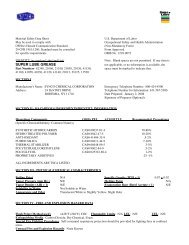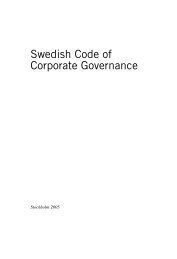The Swedish Corporate Governance Code - Eniro
The Swedish Corporate Governance Code - Eniro
The Swedish Corporate Governance Code - Eniro
Create successful ePaper yourself
Turn your PDF publications into a flip-book with our unique Google optimized e-Paper software.
<strong>The</strong> <strong>Swedish</strong> <strong>Corporate</strong><br />
<strong>Governance</strong> <strong>Code</strong><br />
Applicable from 1 February 2010
This publication can be downloaded or<br />
ordered free of charge from the Board’s website<br />
www.corporategovernanceboard.se<br />
Produced by Hallvarsson & Halvarsson.<br />
Printed by Trosa Tryckeri. Stockholm 2010
Contents<br />
Foreword 2<br />
I. <strong>The</strong> <strong>Swedish</strong> <strong>Code</strong> on <strong>Corporate</strong> <strong>Governance</strong> 3<br />
1 Aims 3<br />
2 Target group 3<br />
3 Guiding principles 4<br />
4 <strong>The</strong> role of the <strong>Corporate</strong><br />
<strong>Governance</strong> Board in <strong>Swedish</strong> self-regulation 4<br />
5 <strong>The</strong> structure and content of the <strong>Code</strong> 5<br />
6 Which companies are to apply the <strong>Code</strong>? 6<br />
II. <strong>The</strong> <strong>Swedish</strong> <strong>Corporate</strong> <strong>Governance</strong> model 8<br />
1 <strong>The</strong> ownership role 9<br />
2 <strong>The</strong> shareholders’ meeting 9<br />
3 <strong>The</strong> board of directors 10<br />
4 <strong>The</strong> chief executive officer 11<br />
5 <strong>The</strong> statutory auditor 12<br />
III. Rules for <strong>Corporate</strong> <strong>Governance</strong> 13<br />
1 <strong>The</strong> shareholders’ meeting 13<br />
2 Appointment and remuneration<br />
of the board and statutory auditor 14<br />
3 <strong>The</strong> tasks of the board of directors 16<br />
4 <strong>The</strong> size and composition of the board 17<br />
5 <strong>The</strong> tasks of directors 19<br />
6 <strong>The</strong> chair of the board 19<br />
7 Board procedures 20<br />
8 Evaluation of the board of<br />
directors and the chief executive officer 21<br />
9 Remuneration of the board and executive management 22<br />
10 Information on corporate governance 24<br />
<strong>The</strong> English language version of the <strong>Swedish</strong> <strong>Corporate</strong> <strong>Governance</strong> <strong>Code</strong> is a<br />
translation of the original <strong>Swedish</strong> text. Where possible differences in interpretation<br />
or errors in translation exist, the <strong>Swedish</strong> text is to take precedence.<br />
<strong>The</strong> <strong>Swedish</strong> <strong>Corporate</strong> <strong>Governance</strong> <strong>Code</strong><br />
1
2<br />
Foreword<br />
This revised <strong>Swedish</strong> <strong>Corporate</strong> <strong>Governance</strong> <strong>Code</strong> is applicable from 1 February 2010.<br />
Transitional rules have been introduced in some areas to the effect that some of the<br />
changes do not need to be applied until a later date.<br />
<strong>The</strong> Board found it necessary to undertake a comprehensive review of the <strong>Code</strong>,<br />
despite the fact that the revised version of the <strong>Code</strong> which was introduced on July 1,<br />
2008 had only been in force for a little over one year. <strong>The</strong> review was prompted by<br />
material changes in legislation and other regulations in the corporate governance area<br />
which emerged in 2009, mainly:<br />
• the EU Commission’s recommendation regarding remuneration of directors in listed<br />
companies (2009/3177/EG),<br />
• new legislation to implement changes to the Fourth and Seventh Company Law Directives<br />
(Chapter 6, Section 6-9 of the Annual Accounts Act (1995:1554) and Chapter 9,<br />
Section 31, third paragraph of the Companies Act (2005:551)),<br />
• new legislation regarding the implementation of the new Eighth Company Law Directive<br />
(Chapter 8, Section 49 a and b of the Companies Act (2005:551)),<br />
• NASDAQ OMX Stockholm’s removal of its requirements regarding board member<br />
independence etc. in its Rule Book For Issuers.<br />
A draft revised <strong>Code</strong> was published on 27 October 2009 for open consultation until<br />
20 November, and about fifteen responses were submitted. <strong>The</strong> Board has thereafter<br />
compiled and analysed the responses and, on this basis, adopted the revised <strong>Code</strong>,<br />
which was published on the Board’s website on 22 December 2009. <strong>The</strong> comments and<br />
proposals received were of great help in this work.<br />
On behalf of the Board, I would like to thank everyone who has contributed to the<br />
content of the revised <strong>Code</strong>.<br />
Stockholm, January 2010<br />
Hans Dalborg<br />
Chair, <strong>The</strong> <strong>Swedish</strong> <strong>Corporate</strong> <strong>Governance</strong> Board<br />
<strong>The</strong> <strong>Swedish</strong> <strong>Corporate</strong> <strong>Governance</strong> <strong>Code</strong>
I. <strong>The</strong> <strong>Swedish</strong> <strong>Code</strong> on<br />
<strong>Corporate</strong> <strong>Governance</strong><br />
1 Aims<br />
Good corporate governance is a question of ensuring that companies are run as<br />
efficiently as possible on behalf of their shareholders. <strong>The</strong> confidence of existing and<br />
potential shareholders that such is the case is crucial to their interest in investing in<br />
companies, thus securing corporate Sweden’s supply of risk capital.<br />
<strong>The</strong> aim of the <strong>Swedish</strong> <strong>Corporate</strong> <strong>Governance</strong> <strong>Code</strong> is to improve confidence in<br />
<strong>Swedish</strong> listed companies by promoting positive development of corporate governance<br />
in these companies. <strong>The</strong> <strong>Code</strong> acts as a complement to legislation and other regulations<br />
by specifying a norm for good corporate governance at a higher level of ambition than<br />
the statutory regulation. However, this norm is not mandatory. Companies may deviate<br />
from individual rules, providing they report each deviation, describe their own solution<br />
and explain why. In this way, the actors in the market can form their own opinions on<br />
the solution the company has chosen.<br />
Another aim of the <strong>Code</strong> is to provide an alternative to legislation. <strong>The</strong> <strong>Swedish</strong><br />
<strong>Corporate</strong> <strong>Governance</strong> Board feels that self-regulation is often preferable to legislation<br />
and sees the <strong>Code</strong> as the primary instrument for this.<br />
2 Target group<br />
<strong>The</strong> target group for the <strong>Code</strong> is <strong>Swedish</strong> companies whose shares are listed on a<br />
regulated market in Sweden. At present, there are two regulated markets in Sweden,<br />
NASDAQ OMX Stockholm and NGM Equity.<br />
<strong>The</strong> companies listed on these markets are of varying size and complexity, ranging<br />
from large, globally active companies to small entrepreneur-run companies. <strong>The</strong> <strong>Code</strong><br />
is applicable to the full spectrum of these companies. This places great demands on the<br />
<strong>Code</strong> to allow flexibility when applying individual rules in practice, but also on companies<br />
to dare to choose solutions other than those specified in the <strong>Code</strong> and to explain<br />
these deviations when they feel they are justified.<br />
<strong>The</strong> <strong>Swedish</strong> <strong>Corporate</strong> <strong>Governance</strong> <strong>Code</strong><br />
3
4<br />
3 Guiding principles<br />
<strong>The</strong> Board’s mission is to ensure that the <strong>Swedish</strong> <strong>Corporate</strong> <strong>Governance</strong> <strong>Code</strong> fulfils<br />
the aims set out above. In concrete terms, this means that the <strong>Code</strong> should<br />
• provide a clear norm for good corporate governance in <strong>Swedish</strong> listed companies<br />
based on established and accepted principles,<br />
• be sufficiently ambitious to provide an alternative to legislation on issues where selfregulation<br />
is preferable, and<br />
• be applicable to all stock exchange listed companies without causing unnecessary<br />
administration or unjustifiable expense.<br />
A further mission is to ensure that the <strong>Code</strong> does not provide obstacles to increased<br />
harmonisation of corporate governance in the Nordic countries.<br />
When the <strong>Code</strong> was originally developed, the <strong>Code</strong> Group, the body that developed<br />
the <strong>Code</strong>, defined a number of guiding principles for its work. <strong>The</strong> <strong>Corporate</strong> <strong>Governance</strong><br />
Board shares the values expressed by these principles, which result in a <strong>Code</strong> that aims to<br />
• create good conditions for active and responsible ownership,<br />
• establish a clear and well-balanced division of roles and responsibilities between<br />
owners, boards and executive management,<br />
• ensure that the principle of equal treatment outlined in the <strong>Swedish</strong> Companies Act is<br />
applied in practice, and<br />
• create a maximum of transparency towards shareholders, the capital markets and<br />
society in general.<br />
4 <strong>The</strong> role of the <strong>Corporate</strong><br />
<strong>Governance</strong> Board in <strong>Swedish</strong> self-regulation<br />
<strong>The</strong> <strong>Corporate</strong> <strong>Governance</strong> Board’s mission is to promote good corporate governance in<br />
<strong>Swedish</strong> listed companies, primarily through managing and administrating the <strong>Code</strong>.<br />
This means that the Board monitors and analyses the practical application of the <strong>Code</strong><br />
and makes any changes deemed required on this basis. <strong>The</strong> Board is one of the four<br />
bodies that constitute the Association for Generally Accepted Principles in the Securities<br />
Market, a non-profit association charged with the mission to administer the private<br />
business sector’s self-regulation within the securities market.<br />
<strong>The</strong> Board’s task in self-regulation is to set norms for good corporate governance in<br />
stock exchange listed companies. <strong>The</strong> Board does not, however, have a supervisory or<br />
ajudicatory role regarding how individual companies apply the <strong>Code</strong>. <strong>The</strong> <strong>Swedish</strong><br />
Securities Council, whose role is to promote good practice on the securities market,<br />
may on request issue statements on how the <strong>Code</strong> should be interpreted. <strong>The</strong> task of<br />
ensuring that companies apply the <strong>Code</strong> adequately falls to the stock exchanges on<br />
which their shares are traded, while judgements on companies’ decisions to comply<br />
with or deviate from the rules of the <strong>Code</strong> are made by the actors in the capital markets.<br />
<strong>The</strong> <strong>Swedish</strong> <strong>Corporate</strong> <strong>Governance</strong> <strong>Code</strong>
<strong>The</strong> <strong>Swedish</strong> <strong>Code</strong> of <strong>Corporate</strong> <strong>Governance</strong><br />
5 <strong>The</strong> structure and content of the <strong>Code</strong><br />
<strong>The</strong> <strong>Code</strong> deals with the decision-making system through which shareholders directly<br />
or indirectly govern the company. <strong>The</strong> main emphasis is on company boards in their<br />
role as central players in corporate governance.<br />
As regards shareholders, the line is drawn at shareholders’ meetings. Issues such as<br />
the interplay between owners and the rules and workings of the stock market are not<br />
covered, nor are issues regarding companies’ relationships with other “stakeholders”,<br />
which are felt to be beyond the framework of a strictly owner-orientated view of corporate<br />
governance.<br />
<strong>The</strong> <strong>Code</strong> forms part of corporate Sweden’s self-regulation. Further corporate governance<br />
rules are set out in the Companies Act, the Annual Accounts Act, the stock<br />
exchanges’ regulations and statements issued by the <strong>Swedish</strong> Securities Council.<br />
<strong>The</strong> <strong>Code</strong> defines a norm for good corporate governance at a more ambitious level<br />
than the minimums specified in the Companies Act and other statutory regulation. <strong>The</strong><br />
key to this is the comply or explain mechanism. This means that companies are not<br />
obliged to comply with every rule in the <strong>Code</strong>, but are allowed the freedom to choose<br />
alternative solutions which they feel are better in their particular circumstances, providing<br />
they report every deviation, describe the alternative solution and explain the<br />
reasons why. In this way, the <strong>Code</strong> specifies what is often, but not necessarily always,<br />
regarded as good corporate governance practice. For individual companies, however,<br />
alternative solutions to those contained in the <strong>Code</strong> may well result in better corporate<br />
governance.<br />
Most of the rules in the <strong>Code</strong> are formulated so as to allow non-compliance to be<br />
identified objectively and explained. For pedagogical reasons, the <strong>Code</strong> also contains<br />
certain rules for which compliance cannot be verified objectively and any non-compliance<br />
is therefore unlikely to be reported. Similarly, it contains some rules which to a<br />
greater or lesser extent can be considered to be logical consequences of legal or regulatory<br />
requirements. Obviously this does not mean that companies can choose to ignore<br />
mandatory provisions of legislation or stock exchange regulations by referring to the<br />
<strong>Code</strong>’s comply or explain mechanism.<br />
<strong>The</strong> <strong>Code</strong> consists of a set of numbered rules. It is with these rules that companies<br />
applying the <strong>Code</strong> must comply or explain. To avoid uncertainty about the requirements,<br />
the phrases “is to” and “may” are used throughout. Some sections of the <strong>Code</strong><br />
have a short introductory text in italics. <strong>The</strong> aim of these introductory texts is to explain<br />
the principles or legislation behind the rules; they are not part of the actual rules and<br />
there is therefore no requirement to comply with them or to report non-compliance. In<br />
addition, some of the rules are accompanied by footnotes. Similarly, the comments in<br />
these footnotes are not part of the rule text and hence also not subject to the comply or<br />
explain mechanism.<br />
<strong>The</strong> <strong>Swedish</strong> <strong>Corporate</strong> <strong>Governance</strong> <strong>Code</strong><br />
5
6<br />
6 Which companies are to apply the <strong>Code</strong>?<br />
It is considered good stock exchange practice for <strong>Swedish</strong> companies whose shares are<br />
admitted to trading on a regulated market to apply the <strong>Code</strong>.<br />
Companies whose shares are admitted to trading on a regulated market are to apply<br />
the <strong>Code</strong> as soon as possible and no later than the date of the first annual general meeting<br />
held after the stock exchange flotation. In the first corporate governance report the<br />
company does not need to report and explain non-compliance with rules that have not<br />
yet been relevant. <strong>The</strong> <strong>Code</strong> is thus to be applied fully from the date of the first annual<br />
general meeting held the year after the stock exchange flotation.<br />
<strong>The</strong> revised <strong>Code</strong> came into force on 1 February 2010 and, apart from the exceptions<br />
listed below, it is to be applied by the companies concerned from that date.<br />
• <strong>The</strong> <strong>Code</strong> rules that have been changed or removed following implementation of<br />
changes to the European Community’s Fourth and Seventh Company Law Directives,<br />
i.e. the rules concerning<br />
- production of a report on internal controls in the second paragraph of rule 7.4,<br />
(previously 10.5),<br />
- the requirement to explain a lack of internal audit, (removed, previously 10.6),<br />
- production of a corporate governance report in rule 10.1, (previously 11.1),<br />
- the content of the corporate governance report in rule 10.2, (previously 11.2), and<br />
- corporate governance information on the company’s website in the first paragraph<br />
of rule 10.3, (previously the first paragraph of 11.3),<br />
are to be applied according to the existing <strong>Code</strong> for financial years commencing<br />
before 1 March 2009. <strong>The</strong> new <strong>Code</strong> rules are to be applied for the first time for years<br />
commencing on or after 28 February 2009. For companies whose financial year corresponds<br />
to the calendar year, this means that any non-compliance with the new<br />
<strong>Code</strong> rules need not be reported until the corporate governance report for the financial<br />
year 2010.<br />
• If during 2009 a company deviated from <strong>Code</strong> rules that were changed or removed as<br />
a result of the implementation of the European Community’s Eighth Company Law<br />
Directive, i.e. rules on the appointment and composition of audit committees in rule<br />
7.3, (previously 10.1), and rules on the tasks of audit committees, (previously 10.2,<br />
now removed), the company does not need to report such non-compliance in its corporate<br />
governance report.<br />
• <strong>The</strong> <strong>Code</strong> rules that have been changed as a result of NASDAQ OMX Stockholm’s<br />
removal of its requirements regarding board member independence, i.e. rules concerning<br />
<strong>The</strong> <strong>Swedish</strong> <strong>Corporate</strong> <strong>Governance</strong> <strong>Code</strong>
<strong>The</strong> <strong>Swedish</strong> <strong>Code</strong> of <strong>Corporate</strong> <strong>Governance</strong><br />
- justification of candidate independence contained in the third paragraph,<br />
fourth bullet of rule 2.6,<br />
- members of the executive management on the board in the footnote to rule 4.3,<br />
- directors’ independence of the company and its executive management in rule 4.4, and<br />
- directors’ independence of major shareholders in new rule 4.5,<br />
are to be applied according to the modified <strong>Code</strong> with regard to individuals elected or<br />
re-elected after 1 July 2010 to boards of <strong>Swedish</strong> companies listed on NASDAQ OMX<br />
Stockholm. For individuals appointed to boards of such companies before that date,<br />
the existing <strong>Code</strong> text and the Board’s Instruction 1-2009 apply. <strong>Swedish</strong> companies<br />
that are listed on NGM Equity are to apply the existing <strong>Code</strong> rules in these areas.<br />
• <strong>The</strong> <strong>Code</strong> rules that have been changed as a result of the EU recommendation regarding<br />
remuneration of directors in listed companies, i.e. rules on<br />
- the tasks and composition of remuneration committees in rules 9.1 and 9.2,<br />
(previously 9.1),<br />
- the use of external consultants in new rule 9.3,<br />
- variable remuneration in new rules 9.4, 9.5 and 9.6,<br />
- share and share-price related incentive programmes in rules 9.7 and 9.8,<br />
(previously 9.7),<br />
- termination packages in new rule 9.9, and<br />
- information on the company’s website in the second and third paragraphs of<br />
rule 10.3, (previously the second and third paragraphs of 11.3),<br />
are to be applied according to the modified <strong>Code</strong> from no later than 1 July 2010.<br />
<strong>The</strong> rule changes in chapter 9 of the <strong>Code</strong> do not mean that companies need to<br />
r enegotiate remuneration agreements signed before 1 July 2010. <strong>The</strong> same applies<br />
to variable remuneration programmes approved by the company before that date.<br />
Companies do not therefore need to report non-compliance with these rules if the noncompliance<br />
is due to agreements signed or programmes approved before 1 July 2010 or<br />
any previous date from which the company has decided to apply the new <strong>Code</strong> rules.<br />
<strong>The</strong> <strong>Swedish</strong> <strong>Corporate</strong> <strong>Governance</strong> <strong>Code</strong><br />
7
8<br />
II. <strong>The</strong> <strong>Swedish</strong> <strong>Corporate</strong><br />
<strong>Governance</strong> model<br />
<strong>Corporate</strong> governance in <strong>Swedish</strong> stock exchange listed companies is regulated by a<br />
combination of written rules and generally accepted practices. <strong>The</strong> framework includes<br />
the <strong>Swedish</strong> Companies Act and the <strong>Swedish</strong> Annual Accounts Act, supported by the<br />
<strong>Swedish</strong> <strong>Code</strong> of <strong>Corporate</strong> <strong>Governance</strong> and the rules of the regulated markets on<br />
which shares are admitted to trading, as well as statements by the <strong>Swedish</strong> Securities<br />
Council on what constitutes good practice in the <strong>Swedish</strong> securities market.<br />
<strong>The</strong> Companies Act contains general regulations about the governance of the company.<br />
<strong>The</strong> Act specifies which governance bodies must exist in a company, the tasks of<br />
each body and the responsibilities of the people in each of these positions. <strong>The</strong> <strong>Code</strong><br />
complements the Act by placing higher demands on companies on certain issues, while<br />
simultaneously allowing them to deviate from rules in individual cases if it is deemed<br />
that this will lead to better corporate governance, (”comply or explain”).<br />
<strong>The</strong> Companies Act stipulates that companies must have three decision-making<br />
bodies in a hierarchical relationship to one another: the shareholders’ meeting, the<br />
board of directors and the chief executive officer. <strong>The</strong>re must also be a controlling body,<br />
the statutory auditor, which is appointed by the shareholders’ meeting.<br />
<strong>The</strong> <strong>Swedish</strong> <strong>Corporate</strong> <strong>Governance</strong> <strong>Code</strong><br />
Owners<br />
S h a r e holders’Meet i ng<br />
Board of D i r ectors<br />
Chief E xecutive O f f icer<br />
Auditor
<strong>The</strong> <strong>Swedish</strong> <strong>Corporate</strong> <strong>Governance</strong> model<br />
1 <strong>The</strong> ownership role<br />
<strong>The</strong> preparatory documents to the <strong>Swedish</strong> Companies Act emphasise the importance<br />
of active ownership. Shareholders provide the business sector with risk capital, but they<br />
also contribute to the efficiency and dynamism of individual companies and the business<br />
sector in general by buying and selling shares, as well as by participating in and<br />
exercising influence at shareholders’ meetings. Active shareholder participation promotes<br />
a healthy balance of power between owners, the board and the executive management.<br />
Ownership structure on the <strong>Swedish</strong> stock market differs significantly from that in<br />
countries such as the United Kingdom or the United States. While the majority of listed<br />
companies in those countries have a very diverse ownership structure, ownership in<br />
Sweden is often concentrated to single or small numbers of major shareholders, as is<br />
the case in many continental European countries. <strong>The</strong>se shareholders often play an<br />
active ownership role and take particular responsibility for the company, for example<br />
by sitting on the board of directors.<br />
<strong>Swedish</strong> society takes a positive view of major shareholders taking particular<br />
responsibility for companies by using seats on boards of directors to actively influence<br />
governance. At the same time, major holdings in companies must not be misused to the<br />
detriment of the company or the other shareholders. <strong>The</strong> Companies Act therefore contains<br />
a number of provisions which offer protection to minority shareholders, such as<br />
requiring qualified majorities for a range of decisions at shareholders’ meetings.<br />
2 <strong>The</strong> shareholders’ meeting<br />
<strong>The</strong> shareholders’ meeting is a limited company’s highest decision-making body and a<br />
forum for shareholders to exercise influence. <strong>The</strong> <strong>Swedish</strong> shareholders’ meeting can<br />
decide on any company issue which does not expressly fall within the exclusive competence<br />
of another corporate body. In other words, the shareholders’ meeting has a sovereign<br />
role over the board of directors and the chief executive officer.<br />
Each shareholder has the right to participate in the shareholders’ meeting and to<br />
vote according to the number of shares owned. Shareholders who are not able to attend<br />
in person may exercise their rights by proxy. Each shareholder also has the right to have<br />
items included in the agenda of the meeting, regardless of the number of shares held,<br />
providing a request has been submitted to the board of directors in due time for the<br />
item to be included in the notice of meeting.<br />
<strong>The</strong> annual general meeting 1 must be held within six months of the end of the financial<br />
year in order to decide on whether to adopt the income statement and balance sheet<br />
and decide on the appropriation of profits or losses. <strong>The</strong> meeting also decides on dis-<br />
1 <strong>The</strong> annual general meeting is the ordinary general meeting where the annual accounts are to be presented.<br />
<strong>The</strong> <strong>Swedish</strong> <strong>Corporate</strong> <strong>Governance</strong> <strong>Code</strong><br />
9
10<br />
charge of liability for members of the board and the chief executive officer, as well as<br />
other issues on which it is obliged by law or its articles of association to decide, such as<br />
the election of members of the board and auditor. Board and auditor fees are also<br />
decided by the shareholders’ meeting.<br />
<strong>The</strong> board may call an extraordinary general meeting if a shareholder minority representing<br />
at least ten per cent of the company’s shares so requests. <strong>The</strong> same applies if<br />
the statutory auditor requests an extraordinary shareholders’ meeting. <strong>The</strong> board may<br />
also call an extraordinary shareholders’ meeting on its own initiative.<br />
Decisions at shareholders’ meetings are taken by simple majority vote. Certain decisions,<br />
however, such as changes to the articles of association, require a qualified majority.<br />
Each share carries one vote, unless otherwise stated in the articles of association. If<br />
the articles of association stipulate that shares have differentiated voting rights, no<br />
share may carry voting rights that are more than ten times that of any other share.<br />
A shareholders’ meeting may not make any decision that aims to give undue advantage<br />
to one shareholder or individual to the disadvantage of the company or any other<br />
shareholder.<br />
3 <strong>The</strong> board of directors<br />
<strong>The</strong> board is responsible for the company’s organisation and the management of the<br />
company’s business. <strong>The</strong> extensive decision-making authority assigned by the law to<br />
the board of directors is primarily limited by the legal provisions giving the shareholders’<br />
meeting exclusive decision-making powers on certain matters, e.g. changes to the<br />
articles of association, election of board members and auditor and adoption of the balance<br />
sheet and income statement.<br />
<strong>The</strong> board is obliged to follow any specific directives passed by the shareholders’<br />
meeting, providing these do not contravene the <strong>Swedish</strong> Companies Act or the company’s<br />
articles of association.<br />
<strong>The</strong> board may delegate tasks to individual members or non-members of the board,<br />
but may not disclaim liability for the company’s organisation and management or its<br />
obligation to ensure satisfactory control of the company’s financial position. When delegating,<br />
the board has an obligation to act responsibly and to monitor that such delegation<br />
can be maintained.<br />
<strong>The</strong> board must specify its ways of working in written Rules of Procedure. If there is<br />
a division of tasks and responsibilities between the members of the board, e.g. if the<br />
board has a committee to prepare certain issues, such as an audit committee, this must<br />
be described in its rules of procedure. <strong>The</strong> board may also delegate decision making to<br />
such a committee, but it may not disclaim responsibility for decisions made on this<br />
basis.<br />
<strong>The</strong> <strong>Swedish</strong> <strong>Corporate</strong> <strong>Governance</strong> <strong>Code</strong>
<strong>The</strong> <strong>Swedish</strong> <strong>Corporate</strong> <strong>Governance</strong> model<br />
<strong>The</strong> board must consist of no fewer than three members, one of which is to be appointed<br />
chair. <strong>The</strong> chair has particular responsibility for leading the work of the board and<br />
ensuring that it fulfils its legal obligations.<br />
<strong>The</strong> <strong>Code</strong> stipulates that no more than one of the directors elected by the shareholders’<br />
meeting may be on the executive management team of the company or one of its<br />
subsidiaries. Normally, this place is taken by the chief executive officer. However, it is<br />
also common that no member of the executive management is a member of the board.<br />
Hence boards of <strong>Swedish</strong> listed companies are composed entirely or predominantly<br />
of non-executive directors. <strong>The</strong> <strong>Code</strong> also states that a majority of the members of the<br />
board are to be independent of the company and its management. At least two members<br />
must also be independent of the company’s major shareholders, 2 which means that it is<br />
possible for major shareholders of <strong>Swedish</strong> companies to appoint a majority of members<br />
with whom they have close ties. This is in line with the positive view of active and<br />
responsible ownership expressed in the preparatory documents to the <strong>Swedish</strong> Companies<br />
Act.<br />
4 <strong>The</strong> chief executive officer<br />
<strong>The</strong> chief executive officer is responsible for the company’s day-to-day management.<br />
Matters of an unusual nature or of exceptional importance due to their scope and the<br />
nature of the company’s business are not considered part of the day-to-day management.<br />
<strong>The</strong> chief executive officer must prepare and present issues that are outside the<br />
scope of day-to-day management to the board of directors. <strong>The</strong> board is to provide written<br />
instructions on when and how the required information is to be collected and<br />
reported to the board.<br />
<strong>The</strong> chief executive officer is subordinate to the board of directors. <strong>The</strong> board may<br />
instruct the chief executive officer on how day-to-day management issues are to be handled<br />
or decided. Within the framework defined by the <strong>Swedish</strong> Companies Act and the<br />
company’s articles of association, the chief executive officer is obliged to follow the<br />
instructions given by the board. <strong>The</strong> board itself may also decide on matters that are a<br />
part of day-to-day management.<br />
<strong>The</strong> chief executive officer may be a member of the board but not its chair. Irrespective<br />
of whether the chief executive officer is a member of the board, he or she has the<br />
right to attend and speak at board meetings providing that the board does not decide<br />
otherwise in a particular circumstance.<br />
2 Major shareholders are defined as those controlling ten per cent or more of the shares or votes in the company.<br />
<strong>The</strong> <strong>Swedish</strong> <strong>Corporate</strong> <strong>Governance</strong> <strong>Code</strong><br />
11
12<br />
5 <strong>The</strong> statutory auditor<br />
<strong>The</strong> company’s statutory auditor is appointed by the shareholders’ meeting to examine<br />
the company’s annual accounts and accounting practices and to review the board’s and<br />
the chief executive officer’s management of the company. In the case of parent companies,<br />
the auditor is also to examine the consolidated accounts. Auditors of <strong>Swedish</strong><br />
companies are therefore given their assignment by, and are obliged to report to, the<br />
owners, and they must not allow their work to be governed or influenced by the board<br />
or the executive management.<br />
Auditors present their reports to the owners at the annual general meeting in the<br />
annual audit report. <strong>The</strong> audit report must contain a statement on whether the annual<br />
report has been compiled in accordance with the relevant legislation. <strong>The</strong> statement is<br />
to specify whether the annual report provides an accurate picture of the company’s<br />
results and position and whether the director’s report is consistent with the rest of the<br />
annual report. If the annual report does not include items that are required by the relevant<br />
legislation, the auditor must state this and, if possible, provide the necessary information<br />
in the audit report. Part of the auditor’s assignment is to recommend whether<br />
the annual shareholders’ meeting should adopt the balance sheet and income statement<br />
and whether the company’s profit or loss should be appropriated in accordance with the<br />
proposals in the director’s report.<br />
<strong>The</strong> auditor is also obliged to report if any member of the board or the chief executive<br />
officer has carried out any action or committed any oversight that may result in liability<br />
for damages. <strong>The</strong> same applies if the auditor has found that any member of the<br />
board or the chief executive officer has acted in any other way that is in breach of the<br />
Companies Act, the relevant legislation on annual accounts or the company’s articles of<br />
association.<br />
<strong>The</strong> <strong>Swedish</strong> <strong>Corporate</strong> <strong>Governance</strong> <strong>Code</strong>
III. Rules for <strong>Corporate</strong><br />
<strong>Governance</strong><br />
1 <strong>The</strong> shareholders’ meeting<br />
Shareholders’ influence in the company is exercised at the shareholders’ meeting,<br />
which is the company’s highest decision-making body. <strong>The</strong> planning and running<br />
of the shareholders’ meeting is to create conditions in which shareholders can<br />
exercise their ownership role in an active, well-informed manner.<br />
1.1 As soon as the time and venue of the shareholders’ meeting have been decided, and<br />
no later than in conjunction with the third quarter report, the information is to be<br />
posted on the company’s website. This information is also to include the closing date<br />
for issues to be submitted by shareholders for inclusion in the notice of meeting.<br />
1.2 <strong>The</strong> notice of meeting and other documents relevant to the shareholders’ meeting<br />
are to be available in such time and in such a form that they provide shareholders<br />
with sufficient opportunity to form a well-founded opinion on the issues raised.<br />
1.3 <strong>The</strong> company chair and as many members of the board as are required for a quorum<br />
are to be present at shareholders’ meetings. <strong>The</strong> chief executive officer is to attend.<br />
At least one member of the company’s nomination committee, at least one of the<br />
company’s auditors and, if possible, each member of the board are to be present<br />
at the annual general meeting.<br />
1.4 <strong>The</strong> company’s nomination committee is to propose a chair for the annual general<br />
meeting. <strong>The</strong> proposal is to be presented in the notice of the meeting.<br />
1.5 <strong>The</strong> shareholders’ meeting is to be conducted in <strong>Swedish</strong> and the material presented<br />
is to be available in <strong>Swedish</strong>. If the ownership structure warrants it, and it<br />
is financially feasible, the company is to offer simultaneous interpretation into<br />
other relevant languages, as well as translation of all or parts of the meeting<br />
documentation.<br />
<strong>The</strong> <strong>Swedish</strong> <strong>Corporate</strong> <strong>Governance</strong> <strong>Code</strong><br />
13
14<br />
1.6 A shareholder, or a representative of a shareholder, who is neither a member of<br />
the board nor an employee of the company is to be appointed to verify the minutes<br />
of the shareholders’ meeting.<br />
1.7 <strong>The</strong> minutes of the latest annual general meeting and any subsequent extraordinary<br />
shareholders’ meetings are to be posted on the company’s website. It is not<br />
necessary to publish the register of voters from the meeting or any attachments<br />
containing such information. <strong>The</strong> minutes are also to be translated from <strong>Swedish</strong><br />
into any other language warranted by the ownership structure, providing this is<br />
financially feasible.<br />
2 Appointment and remuneration<br />
of the board and statutory auditor<br />
<strong>The</strong> shareholder’s meeting’s decisions on election and remuneration of the board<br />
of directors and auditor are to be prepared in a structured, clearly stated process<br />
governed by the shareholders that provides conditions for well-informed decisionmaking.<br />
<strong>The</strong> sole task of the nomination committee is to propose decisions to the shareholders’<br />
meeting on electoral and remuneration issues and, where applicable, procedural<br />
issues for the appointment of the following year’s nomination committee.<br />
Regardless of how they are appointed, members of the nomination committee are<br />
to promote the interests of all shareholders. Members are not to reveal the content<br />
and details of nominations discussions unduly.<br />
2.1 <strong>The</strong> company is to have a nomination committee.<br />
<strong>The</strong> nomination committee is to propose candidates for the post of chair and<br />
other members of the board, as well as fees and other remuneration to each member<br />
of the board.<br />
<strong>The</strong> nomination committee is also to make proposals on the election and<br />
remuneration of the statutory auditor.<br />
2.2 <strong>The</strong> shareholders’ meeting is to appoint members of the nomination committee<br />
or to specify how they are to be appointed.<br />
This decision is to include procedures for replacing members of the nomination<br />
committee who leave before its work is concluded.<br />
<strong>The</strong> <strong>Swedish</strong> <strong>Corporate</strong> <strong>Governance</strong> <strong>Code</strong>
Rules for <strong>Corporate</strong> <strong>Governance</strong><br />
2.3 <strong>The</strong> nomination committee is to have at least three members, one of whom is to<br />
be appointed committee chair.<br />
<strong>The</strong> majority of the members of the nomination committee are to be independent<br />
of the company and its executive management. 1 Neither the chief executive<br />
officer nor other members of the executive management are to be members of the<br />
nomination committee.<br />
At least one member of the nomination committee is to be independent of the<br />
company’s largest shareholder in terms of votes or any group of shareholders that<br />
act in concert in the governance of the company.<br />
2.4 Members of the board of directors may be members of the nomination committee<br />
but may not constitute a majority thereof. Neither the company chair nor any<br />
other member of the board may chair the nomination committee.<br />
If more than one member of the board is on the nomination committee,<br />
no more than one of these may be dependent of a major shareholder in the<br />
company. 2<br />
2.5 <strong>The</strong> company is to announce the names of members of the nomination committee<br />
on its website no later than six months before the annual general meeting. If any<br />
member has been appointed by a particular owner, that owner’s name is to be<br />
stated. If any member leaves the committee, this information is to be published.<br />
If a new member is appointed to the nomination committee, the corresponding<br />
information about the new member is to be provided.<br />
<strong>The</strong> website is also to provide information on how shareholders may submit<br />
recommendations to the nomination committee.<br />
2.6 <strong>The</strong> nomination committee’s proposals are to be presented in the notice of a<br />
shareholders’ meeting where the election of board members or auditor is to be<br />
held and on the company’s website.<br />
When the notice of the shareholders’ meeting is issued, the nomination committee<br />
is to issue a statement on the company’s website explaining its proposals<br />
regarding the board of directors with regard to the requirements concerning the<br />
composition of the board contained in <strong>Code</strong> rule 4.1. If the outgoing chief executive<br />
officer is nominated for the post of chair, reasons for this proposal are also to<br />
be fully explained.<br />
1 For criteria for assessing independence, see 4.4.<br />
2 For criteria for assessing independence, see 4.5.<br />
<strong>The</strong> <strong>Swedish</strong> <strong>Corporate</strong> <strong>Governance</strong> <strong>Code</strong><br />
15
16<br />
<strong>The</strong> following information on candidates nominated for election or re-election to<br />
the board is to be posted on the company’s website:<br />
• <strong>The</strong> candidate’s age, principal education and work experience,<br />
• any work performed for the company and other significant professional commitments,<br />
• any holdings of shares and other financial instruments in the company and any<br />
such holdings owned by the candidate or the candidate’s related natural or legal<br />
persons,<br />
• whether the nomination committee, in accordance with <strong>Code</strong> rules 4.4 and 4.5,<br />
deems the candidate to be independent of the company and its senior management,<br />
as well as of major shareholders in the company. Where circumstances<br />
listed respectively in paragraph 2, bullets 1 to 7 of 4.4 and the first sentence in<br />
paragraph 2 of 4.5 exist, the nomination committee is to justify its position<br />
regarding candidates’ independence,<br />
• in the case of re-election, the year that the person was first elected to the board.<br />
2.7 At a shareholders’ meeting where the election of board members or auditor is to<br />
be held, the nomination committee is to give an account of how it has conducted<br />
its work and explain its proposals.<br />
3 <strong>The</strong> tasks of the board of directors<br />
<strong>The</strong> board of directors is to manage the company’s affairs in the interests of the<br />
company and all shareholders.<br />
3.1 <strong>The</strong> principle tasks of the board of directors include<br />
• establishing the overall operational goals and strategy of the company,<br />
• appointing, evaluating and, if necessary, dismissing the chief executive officer,<br />
• ensuring that there is an effective system for follow-up and control of the company’s<br />
operations,<br />
• ensuring that there is a satisfactory process for monitoring the company’s compliance<br />
with laws and other regulations relevant to the company’s operations,<br />
• defining necessary guidelines to govern the company’s ethical conduct,<br />
• ensuring that the company’s external communications are characterised by<br />
openness, and that they are accurate, reliable and relevant.<br />
3.2 <strong>The</strong> board is to approve any significant assignments the chief executive officer<br />
has outside the company.<br />
<strong>The</strong> <strong>Swedish</strong> <strong>Corporate</strong> <strong>Governance</strong> <strong>Code</strong>
Rules for <strong>Corporate</strong> <strong>Governance</strong><br />
4 <strong>The</strong> size and composition of the board<br />
<strong>The</strong> board is to have a size and composition that enables it to manage the<br />
company’s affairs efficiently and with integrity.<br />
4.1 <strong>The</strong> board is to have a composition appropriate to the company’s operations,<br />
phase of development and other relevant circumstances. <strong>The</strong> board members<br />
elected by the shareholders’ meeting are collectively to exhibit diversity and<br />
breadth of qualifications, experience and background. <strong>The</strong> company is to strive<br />
for equal gender distribution on the board.<br />
4.2 Deputies for directors elected by the shareholders’ meeting are not to be<br />
appointed.<br />
4.3 No more than one member of the board may be a member of the executive management<br />
of the company or a subsidiary. 3<br />
4.4 <strong>The</strong> majority of the directors elected by the shareholders’ meeting are to be independent<br />
of the company and its executive management.<br />
A director’s independence is to be determined by a general assessment of all<br />
factors that may give cause to question the individual’s independence of the company<br />
or its executive management. Factors that should be considered include 4<br />
• whether the individual is the chief executive officer or has been the chief executive<br />
officer of the company or a closely related company within the last five<br />
years,<br />
• whether the individual is employed or has been employed by the company or a<br />
closely related company within the last three years,<br />
• whether the individual receives a not insignificant remuneration for advice or<br />
other services beyond the remit of the board position from the company, a closely<br />
related company or a person in the executive management of the company,<br />
• whether the individual has or has within the last year had a significant business<br />
relationship or other significant financial dealings with the company or a closely<br />
related company as a client, supplier or partner, either individually or as a mem-<br />
3 <strong>The</strong> chief executive officer and an executive chair of the board may thus not both be members of the board if<br />
the latter is also a member of the company’s executive management. A member of the board may, however,<br />
be employed and receive remuneration from the company, e.g. a member of the board who is honorary chair<br />
of the board or who acts as an “ambassador” for the company or similar.<br />
4 <strong>The</strong> results of the nomination committee’s deliberations are to be reported in accordance with the fourth<br />
bullet of the third paragraph in 2.6.<br />
<strong>The</strong> <strong>Swedish</strong> <strong>Corporate</strong> <strong>Governance</strong> <strong>Code</strong><br />
17
18<br />
ber of the executive management, a member of the board or a major shareholder<br />
in a company with such a business relationship with the company, 5<br />
• whether the individual is or has within the last three years been a partner at, or<br />
has as an employee participated in an audit of the company conducted by, the<br />
company’s or a closely related company’s current or then auditor,<br />
• whether the individual is a member of the executive management of another<br />
company if a member of the board of that company is a member of the executive<br />
management of the company, or<br />
• whether the individual has a close family relationship with a person in the<br />
executive management or with another person named in the points above if<br />
that person’s direct or indirect business with the company is of such magnitude<br />
or significance as to justify the opinion that the board member is not to be<br />
regarded as independent.<br />
A closely related company is defined in this context as another company in which<br />
the company holds, directly or indirectly, at least ten per cent of the shares,<br />
o wnership interest or votes, or a financial share that confers an entitlement of at<br />
least ten per cent of the yield. If the company owns more than 50 per cent of the<br />
shares, ownership interest or votes in another company, it is to be regarded as<br />
indirectly holding the latter company’s ownership in other companies.<br />
4.5 At least two of the members of the board who are independent of the company<br />
and its executive management are also to be independent in relation to the company’s<br />
major shareholders.<br />
In order to determine a board member’s independence, the extent of the member’s<br />
direct and indirect relationships with major shareholders is to be taken into<br />
consideration 6 . A member of the board who is employed by or is a board member<br />
of a company which is a major shareholder is not to be regarded as independent.<br />
In this context, a major shareholder is defined as controlling, directly or indirectly,<br />
at least ten per cent of the shares or votes in the company. If a company<br />
owns more than 50 per cent of the shares, ownership interest or votes in another<br />
company, the former is regarded as having indirect control of the latter company’s<br />
ownership in other companies.<br />
4.6 Nominees are to provide the nomination committee with sufficient information to<br />
enable an assessment of the candidate’s independence as defined in 4.4 and 4.5.<br />
5 This point is not to be regarded as applicable to a normal business relationship as a customer of a bank.<br />
6 <strong>The</strong> results of the nomination committee’s deliberations are to be reported in accordance with the fourth<br />
bullet of the third paragraph in 2.6.<br />
<strong>The</strong> <strong>Swedish</strong> <strong>Corporate</strong> <strong>Governance</strong> <strong>Code</strong>
Rules for <strong>Corporate</strong> <strong>Governance</strong><br />
4.7 Members of the board are to be appointed for a period extending no longer than<br />
to the end of the next annual general meeting.<br />
5 <strong>The</strong> tasks of directors<br />
Directors are to devote the necessary time and care, and to ensure they have the<br />
competence required, to effectively protect and promote the interests of the company<br />
and its owners. To enable it to make well-founded decisions, the chief executive<br />
officer is to provide the board with the necessary background information<br />
and documentation for its work, both before and between board meetings.<br />
5.1 Each director is to form an independent opinion on each matter considered by the<br />
board and to request whatever information he or she believes necessary for the<br />
board to make well-founded decisions.<br />
5.2 Each director is obliged to acquire the knowledge of the company’s operations,<br />
organisation, markets etc., required for the assignment.<br />
6 <strong>The</strong> chair of the board<br />
<strong>The</strong> chair has a particular responsibility to ensure that the work of the board is<br />
well organised and conducted efficiently.<br />
6.1 <strong>The</strong> chair of the board is to be elected by the shareholders’ meeting. If the chair<br />
relinquishes the position during the mandate period, the board is to elect a chair<br />
from among its members to serve until the end of the next annual general meeting.<br />
6.2 If the chair of the board is an employee of the company or has duties assigned by<br />
the company in addition to his or her responsibilities as chair, the division of<br />
work and responsibilities between the chair and the chief executive officer is to be<br />
clearly stated in the board’s statutory Rules of Procedure and its Instruction to<br />
the chief executive officer.<br />
6.3 <strong>The</strong> chair is to ensure that the work of the board is conducted efficiently and that<br />
the board fulfils its obligations. In particular, the chair is to<br />
• organise and lead the work of the board, creating the best possible conditions<br />
for the board’s activities,<br />
• ensure that new board members receive the necessary introductory training,<br />
as well as any other training that the chair and member agree is appropriate,<br />
• ensure that the board regularly updates and develops its knowledge of the com<br />
pany and its operations,<br />
<strong>The</strong> <strong>Swedish</strong> <strong>Corporate</strong> <strong>Governance</strong> <strong>Code</strong><br />
19
20<br />
• be responsible for contacts with the shareholders regarding ownership issues<br />
and communicate shareholders’ views to the board,<br />
• ensure that the board receives sufficient information and documentation to<br />
enable it to conduct its work,<br />
• in consultation with the chief executive officer, draw up proposed agendas for<br />
the board’s meetings,<br />
• verify that the board’s decisions are implemented, and<br />
• ensure that the work of the board is evaluated annually.<br />
7 Board procedures<br />
<strong>The</strong> formal procedures for the work of the board of directors are to be stipulated<br />
by the board. <strong>The</strong>se procedures are to be clear and well documented.<br />
7.1 <strong>The</strong> board is to review the relevance and appropriateness of its statutory Rules of<br />
Procedure, Instruction to the chief executive officer and Reporting instruction at<br />
least once a year.<br />
7.2 If the board establishes special committees to prepare its decisions on specific<br />
issues, its Rules of Procedure are to specify the duties and decision-making powers<br />
that the board has delegated to these committees and how the committees are to<br />
report to the board. Committees are to keep minutes of their meetings and the<br />
minutes are to be made available to the board.<br />
7.3 An audit committee 7 is to comprise no fewer than three board members. <strong>The</strong><br />
majority of the members of the committee are to be independent of the company<br />
and its executive management. At least one of the committee members who are<br />
independent of the company and its executive management is also to be independent<br />
of the company’s major shareholders 8 .<br />
7.4 <strong>The</strong> board is to ensure that the company has adequate internal controls and formalised<br />
routines to ensure that approved principles for financial reporting and<br />
7 Stipulations on the appointment of an audit committee and the tasks of the committee are to be found in<br />
chapter 8, sections 49 a-b of the <strong>Swedish</strong> Companies Act (2006:551). Chapter 8, section 49a, parapraph 2<br />
states that the entire board may perform the tasks of the audit committee.<br />
8 Chapter 8, section 49a, paragraph 1 of the <strong>Swedish</strong> Companies Act (2006:551) states that members of the<br />
committee may not be employees of the company, and that at least one committee member is to be independent<br />
of the company and its executive management, as well as the company’s major shareholders. This<br />
member must also have auditing or accounting competence. For critieria for assessing independence, see<br />
4.4 and 4.5.<br />
<strong>The</strong> <strong>Swedish</strong> <strong>Corporate</strong> <strong>Governance</strong> <strong>Code</strong>
Rules for <strong>Corporate</strong> <strong>Governance</strong><br />
internal controls are applied, and that the company’s financial reports are produced<br />
in accordance with legislation, applicable accounting standards and other<br />
requirements for listed companies.<br />
For companies that do not have a separate internal audit function, the board of<br />
directors is to evaluate the need for such a function annually and to justify its<br />
decision in its report on internal controls in the company’s corporate governance<br />
report. 9<br />
7.5 At least once a year, the board is to meet the company’s statutory auditor without<br />
the chief executive officer or any other member of the executive management<br />
present.<br />
7.6 <strong>The</strong> board of directors is to ensure that the company’s six- or nine-month report<br />
is reviewed by the statutory auditor.<br />
7.7 <strong>The</strong> minutes of the board are to provide a clear representation of the matters discussed,<br />
the material supporting each item and the substance of the decisions<br />
taken. <strong>The</strong> minutes are to be sent to each member of the board as soon as possible<br />
following the board meeting.<br />
8 Evaluation of the board of directors and the chief executive<br />
officer<br />
Regular and systematic evaluation forms the basis for assessment of the performance<br />
of the board and the chief executive officer and for the continuous development<br />
of their work.<br />
8.1 <strong>The</strong> board of directors is to evaluate its work annually, using a systematic and<br />
structured process, with the aim of developing the board’s working methods and<br />
efficiency. <strong>The</strong> results of this evaluation are to be made available to the nomination<br />
committee where relevant.<br />
8.2 <strong>The</strong> board is to continuously evaluate the work of the chief executive officer. <strong>The</strong><br />
board is to examine this issue formally at least once a year, and no member of the<br />
executive management is to be present during this formal evaluation process.<br />
9 <strong>The</strong> inclusion of a report on internal controls and risk management in the company’s corporate governance<br />
report is a requirement stipulated in chapter 6, section 6, paragraph 2, bullet 2 of the Annual Accounts Act<br />
(1995:1554).<br />
<strong>The</strong> <strong>Swedish</strong> <strong>Corporate</strong> <strong>Governance</strong> <strong>Code</strong><br />
21
22<br />
9 Remuneration 10 of the board and executive management 11<br />
<strong>The</strong> company is to have formal and openly stated processes for deciding on remuneration<br />
of members of the board and the executive management.<br />
Remuneration and other terms of employment of members of the board and the<br />
executive management are to be designed with the aim of ensuring that the company<br />
has access to the competence required at a cost appropriate to the company,<br />
and so that they have the intended effects for the company’s operations.<br />
9.1 <strong>The</strong> board is to establish a remuneration committee, whose main tasks are to<br />
• prepare the board’s decisions on issues concerning principles for remuneration,<br />
remunerations and other terms of employment for the executive management,<br />
• monitor and evaluate programmes for variable remuneration, both ongoing<br />
and those that have ended during the year, for the executive management, and<br />
• monitor and evaluate the application of the guidelines for remuneration that<br />
the annual general meeting is legally obliged to establish 12 , as well as the current<br />
remuneration structures and levels in the company.<br />
9.2 <strong>The</strong> chair of the board may chair the remuneration committee. <strong>The</strong> other shareholders’<br />
meeting-elected members of the committee are to be independent of<br />
the company and its executive management. 13 Appropriate knowledge and<br />
experience of executive remuneration issues is to exist among the members of<br />
the committee.<br />
If the board considers it is more appropriate, the entire board may perform the<br />
remuneration committee’s tasks, on condition that no board member who is also<br />
a member of the executive management participates in this work.<br />
10 For the purposes of this chapter, pay is defined as (i) fixed salary or fee, (ii) variable remuneration, including<br />
share- and share-price-related incentive programmes, (iii) pension schemes, and (iv) other financial benefits.<br />
11 <strong>The</strong> term “board and the executive management” refers to individuals whose compensation and benefits are<br />
to be reported separately by the company according to chapter 5, section 20, paragraphs 1 and 3 of the<br />
Annual Accounts Act, (1995:1554), i.e. members of the board, the chief executive officer and each member of<br />
the company’s executive management. <strong>The</strong> term executive management refers to this same group of people<br />
with the exception of members of the board.<br />
12 <strong>The</strong> stipulation that the annual general meeting is to establish guidelines for executive remuneration is to be<br />
found in chapter 7, section 61 of the <strong>Swedish</strong> Companies Act (2005:551). <strong>The</strong> guidelines are to contain the<br />
criteria stated in chapter 8, section 51, paragraph 1 and section 52, paragraph 1 of the Act. <strong>The</strong> Act specifically<br />
states that the guidelines are not to cover fees and other remuneration for board work.<br />
13 For criteria for assessing independence, see 4.4.<br />
<strong>The</strong> <strong>Swedish</strong> <strong>Corporate</strong> <strong>Governance</strong> <strong>Code</strong>
Rules for <strong>Corporate</strong> <strong>Governance</strong><br />
9.3 If the remuneration committee or the board uses the services of an external consultant,<br />
it is to ensure that there is no conflict of interest regarding other assignments<br />
this consultant may have for the company or its executive management.<br />
9.4 Variable remuneration is to be linked to predetermined and measurable performance<br />
criteria 14 aimed at promoting the company’s long term value creation.<br />
9.5 Variable remuneration paid in cash is to be subject to predetermined limits<br />
regarding the total outcome. 15<br />
9.6 When designing systems for variable remuneration of the executive management<br />
that is to be paid in cash, the board is to consider imposing restrictions<br />
• which make payment of a certain proportion of the remuneration conditional<br />
on whether the performance on which compensation is based proves to be sustainable<br />
over time, and<br />
• which allow the company to reclaim components of remuneration that have<br />
been paid on the basis of information which later proves to be manifestly<br />
misstated.<br />
9.7 <strong>The</strong> shareholders’ meeting is to decide on all share and share-price related incentive<br />
schemes for the executive management. <strong>The</strong> decision of the shareholders’<br />
meeting is to include all the principle conditions of the scheme.<br />
Background material and documentation pertaining to the proposed scheme is<br />
to be made available to shareholders in good time before the shareholders’ meeting.<br />
<strong>The</strong> material is to be clear and simple enough to allow shareholders to form<br />
an opinion on the reasons for the scheme, the principle conditions of the scheme<br />
and any dilution of the share capital that may result from it, as well as the total<br />
cost to the company of different conceivable outcomes.<br />
9.8 Share- and share-price-related incentive programmes are to be designed with the<br />
aim of achieving increased alignment between the interests of the participating<br />
individual and the company’s shareholders.<br />
14 <strong>The</strong> criteria may be of different kinds, including own investment, e.g. through participation in a share savings<br />
programme. <strong>The</strong> term measurable is used to indicate that it should be possible to evaluate to what<br />
extent the criteria have been fulfilled.<br />
15 Such limits do not need to be specified as cash amounts, but may also be defined in other ways.<br />
<strong>The</strong> <strong>Swedish</strong> <strong>Corporate</strong> <strong>Governance</strong> <strong>Code</strong><br />
23
24<br />
Programmes that involve acquisition of shares are to be designed so that a<br />
personal holding of shares in the company is promoted. <strong>The</strong> vesting period or the<br />
period from the commencement of an agreement to the date for acquisition of<br />
shares is to be no less than three years.<br />
Non-executive members of the board are not to participate in programmes<br />
designed for the executive management or other employees. Remuneration of<br />
non-executive board members is not to include share options.<br />
9.9 Fixed salary during a period of notice and severance pay are together not to<br />
exceed an amount equivalent to the individual’s fixed salary for two years.<br />
10 Information on corporate governance<br />
<strong>The</strong> board of directors is to inform shareholders and the capital market annually<br />
regarding corporate governance functions in the company and how the company<br />
applies the <strong>Swedish</strong> <strong>Corporate</strong> <strong>Governance</strong> <strong>Code</strong>. This information is to be published<br />
in a corporate governance report 16 and on the company’s website.<br />
10.1 In its corporate governance report, the company is to state clearly which <strong>Code</strong><br />
rules it has not complied with, explain the reasons for each case of non-compliance<br />
and describe the solution it has adopted instead.<br />
10.2 As well as the items stipulated by legislation 17 , the following information is to be<br />
included in the corporate governance report if it is not presented in the annual<br />
report:<br />
• the composition of the company’s nomination committee. If any member of the<br />
committee has been appointed by a particular owner, the name of this owner is<br />
also to be stated,<br />
• the information on each member of the board that is required by <strong>Code</strong> rule 2.6,<br />
• the division of work among members of the board and how the work of the board<br />
was conducted during the most recent financial year, including the number of<br />
board meetings held and each member’s attendance at board meetings,<br />
• the composition, tasks and decision-making authority of any board committees,<br />
and each member’s attendance at the respective committee’s meetings,<br />
16 <strong>The</strong> requirement to produce a corporate governance report is stipulated in chapter 6, sections 8 and 9 of the<br />
Annual Accounts Act (1995:1554).<br />
17 <strong>The</strong> information to be included in the corporate governance report is stipulated in chapter 6, section 6 of the<br />
Annual Accounts Act (1995:1554).<br />
<strong>The</strong> <strong>Swedish</strong> <strong>Corporate</strong> <strong>Governance</strong> <strong>Code</strong>
• for the chief executive officer:<br />
- age, principal education and work experience,<br />
- significant professional commitments outside the company, and<br />
- holdings of shares and other financial instruments in the company or similar<br />
holdings by related natural or legal persons, as well as shareholdings and part<br />
ownership in enterprises with which the company has significant business<br />
relations,<br />
• any infringement of the stock exchange rules applicable to the company, or any<br />
breach of good practice on the securities market reported by the relevant<br />
exchange’s disciplinary committee or the <strong>Swedish</strong> Securities Council during<br />
the most recent financial year.<br />
10.3 <strong>The</strong> company is to have a section of its website devoted to corporate governance<br />
matters, where the company’s three most recent corporate governance reports<br />
are to be posted, together with that part of the audit report which deals with the<br />
corporate governance report or the auditor’s written statement on the corporate<br />
governance report 18 .<br />
<strong>The</strong> corporate governance section of the website is to include the company’s<br />
current articles of association, along with any other information required by the<br />
<strong>Code</strong>. 19 It is also to include up to date 20 information regarding<br />
• members of the board, the chief executive officer and the statutory auditor,<br />
• a description of the company’s system of variable remuneration to the board<br />
and executive management, and of each outstanding share- and share-pricerelated<br />
incentive scheme.<br />
No later than two weeks before the annual general meeting, the board is also to<br />
report the results of the evaluation required by bullets two and three of <strong>Code</strong> rule<br />
9.1 on the company’s website.<br />
18 <strong>The</strong> requirement for an auditor review of the corporate governance report if it is included in the director’s<br />
report or of the information that is otherwise found in the company’s or group’s director’s report is stipulated<br />
in chapter 9, section 31 of the Companies Act (2005:551). <strong>The</strong> requirement for auditor review if the corporate<br />
governance report is published separately from the annual report is stipulated in chapter 6, section 9<br />
of the Annual Accounts Act (1995:1554).<br />
19 See 1.1, 1.7, 2.5 and 2.6.<br />
20 <strong>The</strong> term up to date is to be interpreted as meaning that the information is to be updated within seven days<br />
of any changes made or becoming known to the company.
PO Box 7680 | SE-103 95 Stockholm, Sweden<br />
www.corporategovernancereport.se


